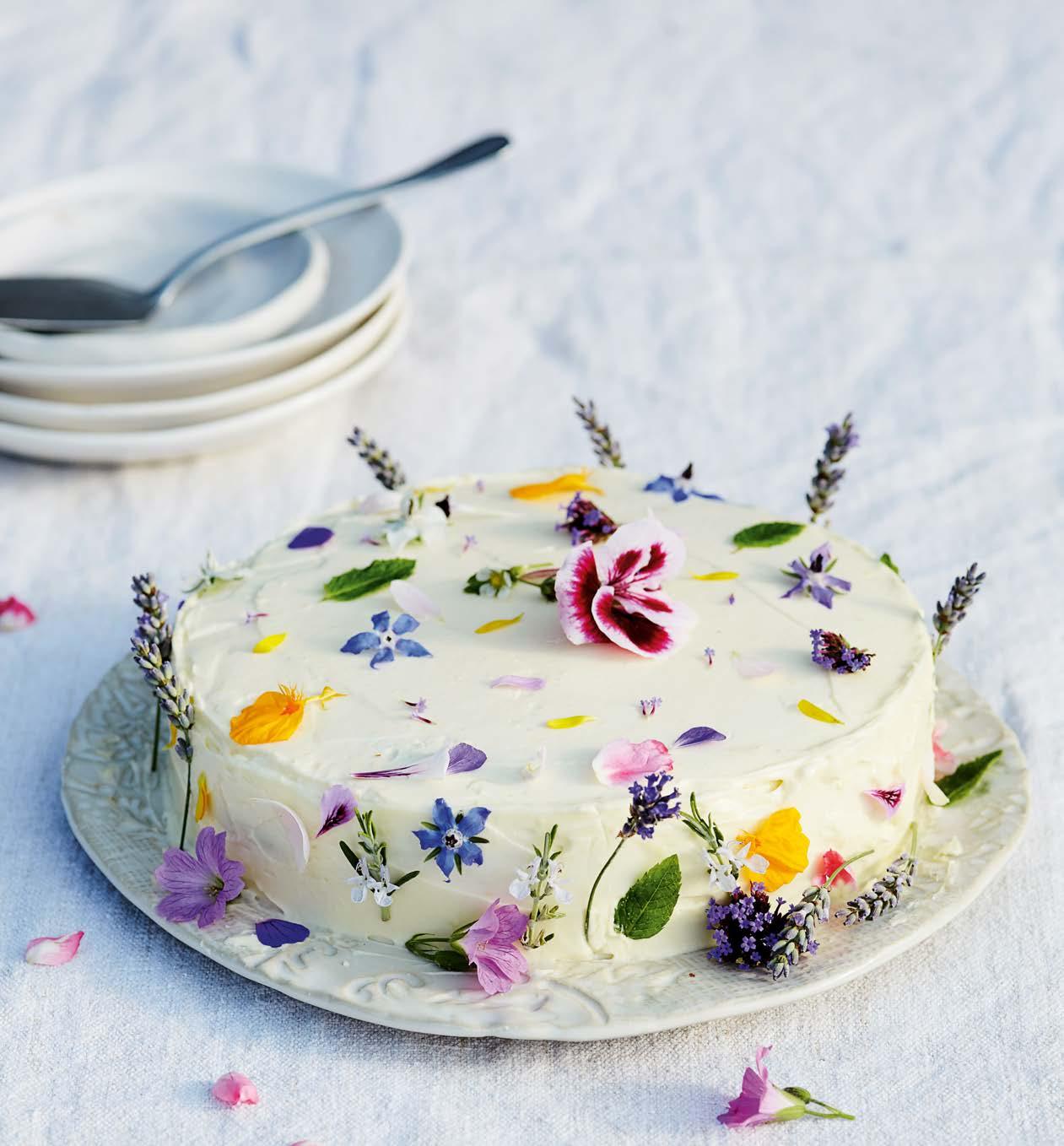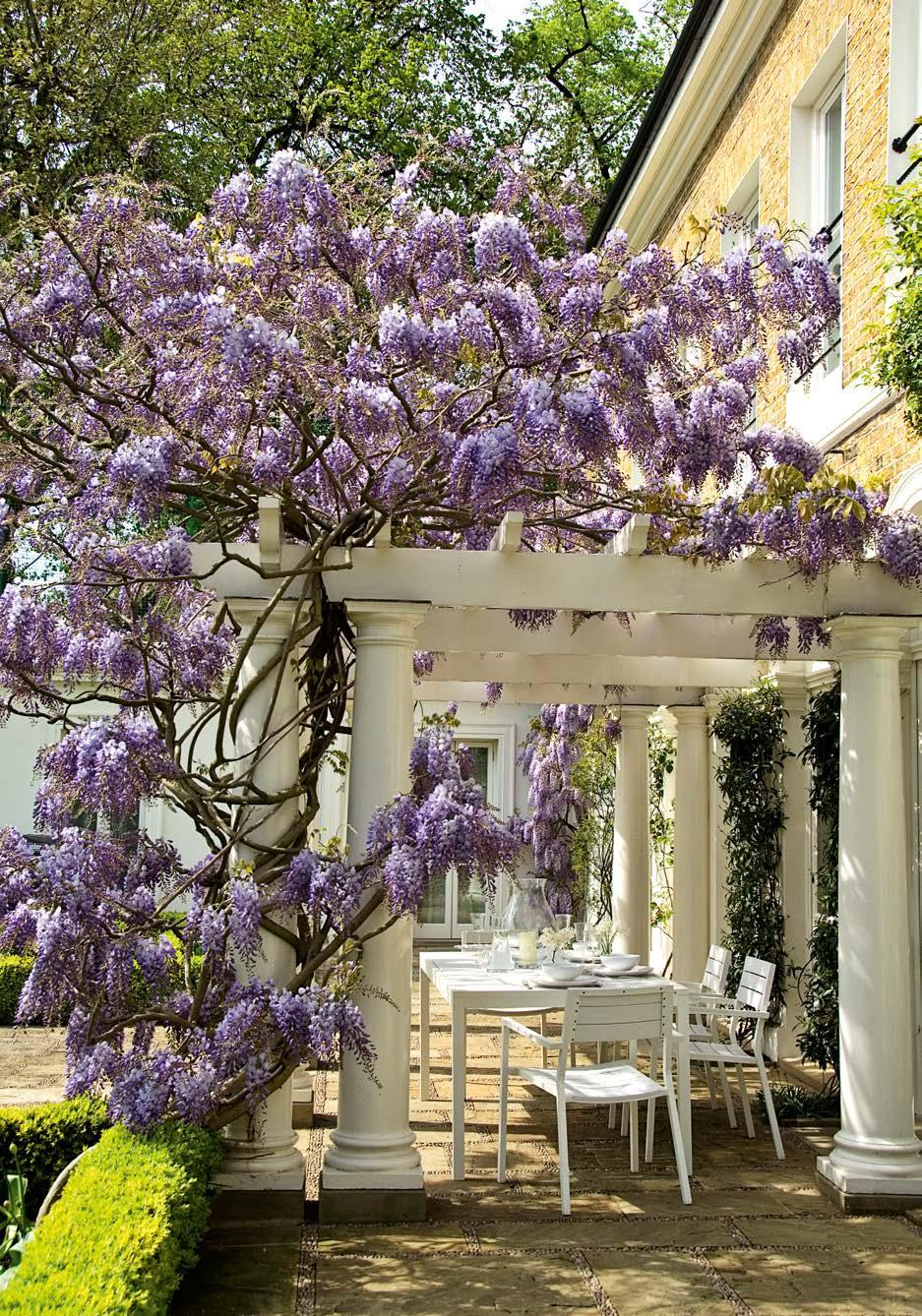
11 minute read
Wisteria Jacky Hobbs guides would-be
Wisterias have universal appeal, embellishing elegant town houses and thatched country cottages with equal aplomb. Bursting into bloom before the lime-green, pinnate foliage emerges, smothering and covering facades with a wash of dangling, fragrant, lilac tresses, its springtime floral display is unparalleled. At up to ten metres tall and five metres across, a single plant can engulf an entire property and deservedly capture the limelight. Instagrammers clamour to share sensational, flower-infused images – #wisteriahysteria – and London even has seasonal wisteria walks. Chris O’Keefe, professional wisteria pruner and founder of the London Wisteria Company, explains the power of wisterias in bloom: “They stop you in your tracks and put a smile on your face. Wisteria transform the ordinary into the extraordinary, highlighting beauty or concealing eyesores,” he says. These coveted climbers have become almost a status symbol in the city; quintessentially English in the country. “A London property with virtually no garden can put on an astonishing flower show, its entire facade smothered in masses of elegant blooms for weeks on end,” adds Chris. Wisteria’s perfume drifts freely through open doors and windows and attracts throngs of pollinators. Wisterias are hardy and longlived. Britain’s first wisteria, Wisteria sinensis, arrived from China in 1816 and still thrives in Kew’s Royal Botanic Gardens – so plant your wisteria wisely. Chinese Wisteria sinensis and Japanese native W. floribunda are the two most popular species. They flower in mid- to late-April, May or June, are lilac in colour and heavily perfumed. Generally, Chinese wisteria, W. sinensis, climbs in a clockwise direction and bears plump, shortish 25-30cm, lilac flower panicles that bloom just before the foliage emerges. The most widespread, infallible, Chinese wisteria in cultivation is the very vigorous and floriferous W. sinensis ‘Prolific’, holder of an Award of Garden Merit (AGM). “It’s one of the very best for flowers,” remarks Chris. It blooms early in its life and at the beginning of the season, from mid- to late-April. Its vibrant, redflushed violet-blue cousin, W. sinensis ‘Amethyst’ (AGM), is equally reliable. Both are heavily scented and excellent for clothing the facade of a house, sending up trees, shrouding pergolas or running along walls and fences.
Japanese wisteria, W. floribunda, spiral in the opposite direction, anti-clockwise, and produce their cascades of long, elegant, pendulous floral
Above Wisteria is one of only a few climbers able to match the proportions of a substantial portico, colonnade or pergola, and enhance it. This one is Wisteria sinensis.
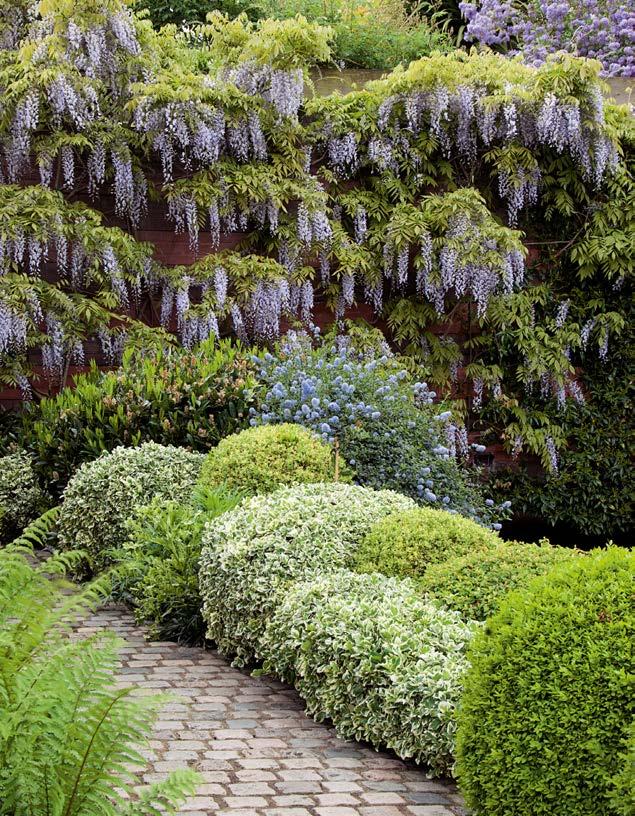

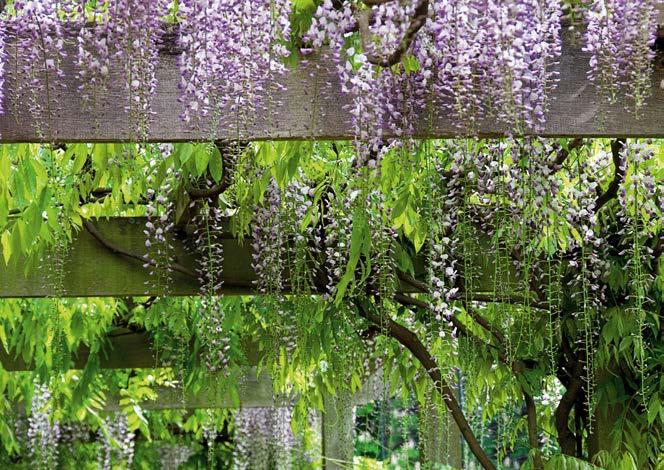
Top left The showy white flowers of W. floribunda f. alba ‘Shiro-noda’. Top right Wisteria sinensis, neatly trained to beautify a wall. Far left Close inspection of wisteria’s flowers reveals its pea family characteristics. Left Professional pruner Chris O’Keefe, founder of the London Wisteria Company. Bottom Wisteria floribunda ‘Multijuga’.
racemes, some a metre long, at the same time as their foliage appears. These are best enjoyed cascading from arbours, tunnels, archways and pergolas. Japan’s annual Wisteria Festival, Fuji Matsuri, showcases tunnels dripping with a pastel rainbow of perfumed racemes in every shade of lavender, pink and white.
Wisteria floribunda f. rosea ‘Hon-beni’ (AGM) is the rosiest of all pinks, bearing 50-60cm long tresses with unrivalled perfume. ‘Hon-beni’ can be trained as a standard and is renowned for flowering early in its life, but later in the season, from mid-May. W. floribunda f. alba ‘Shiro-noda’ produces showy, 60cm-long, white blooms, while double-flowered W. floribunda ‘Yae-kokuryu’ (often offered for sale


SUMMER PRUNING
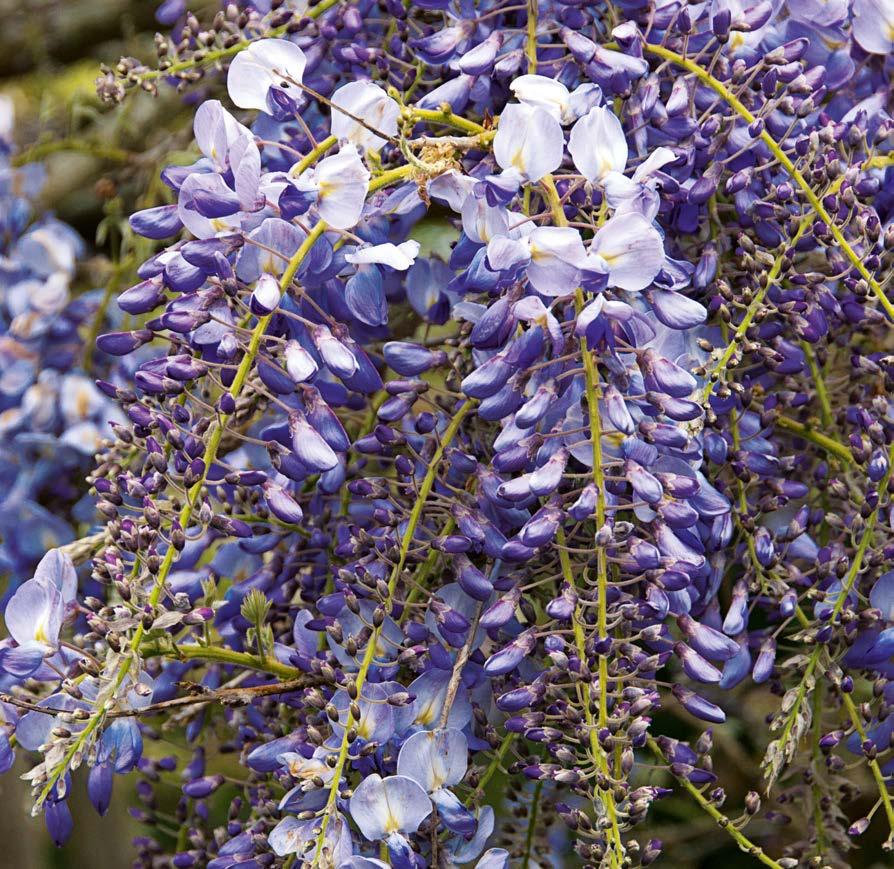
After flowering, in July or August, shorten the current year’s growth – all those long, unruly and unnecessary shoots – to five-to-six leaves, or to around 15cm. This encourages flower-bud production over leaves and exposes the stubbier, woody side arms to full sun to encourage more blooms next year.
BEFORE

AFTER
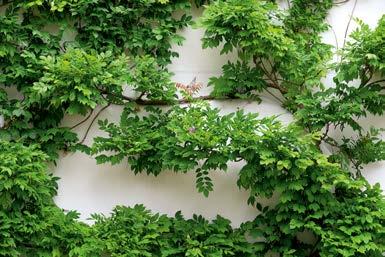

Top left Wisteria sinensis ‘Consequa’ is a robust grower with violet-blue flowers and is a superb choice for walls. Top right Wisteria ‘Shiro-kapitan’, with its 10-20cm long flowers. Above Wisteria floribunda f. rosea ‘Honbeni’ is the variety to go for if you’re seeking pink flower racemes. as Wisteria ‘Black Dragon’) has darker, indigo-black blooms. The most vigorous and enchanting of all floribundas is award-winning, long-flowering Wisteria floribunda f. multijuga (AGM), which has exceptional, metre-long, densely clustered, lilac and purple blooms. An earlier-flowering Japanese species, silky wisteria or W. brachybotrys, is noteworthy for its immense vigour. Its climbing ability exceeds that of all other wisterias: it can scramble beyond 12 metres and spread at least eight. The versatile white cultivar W. brachybotrys f. albiflora ‘Shiro-kapitan’ (AGM), can scale great heights, but also makes a good container plant for the small garden. Chris recommends it for its fantastic fragrance. Purple species Wisteria brachybotrys and outstanding cultivar ‘Okayama’ are very similar and favoured by Chris for vibrancy and unparalleled vigour. AGM holder ‘Okayama’ bears masses of fragrant but much shorter blooms that are 15cm long, amid dark bronze foliage.
Wisteria are versatile, hardy, relatively quickgrowing and prolific if you follow a few essential rules. “Buy a five- to seven-year-old grafted plant, since younger plants rarely flower, and plant when dormant (October-March) in a sunny, sheltered south- or south-west-facing position,” Chris advises. “The foot of a wall is ideal as it will protect flower buds against late frosts. Plant in rich, moist but free-draining soil, leaving plenty of room for root growth. Poor drainage can inhibit flowers,” he adds.

WISTERIA PRUNING Step by step
Wisteria are pruned twice: first in winter (shown here) followed by a summer prune (opposite page). Do this every year and spectacular floral displays will follow
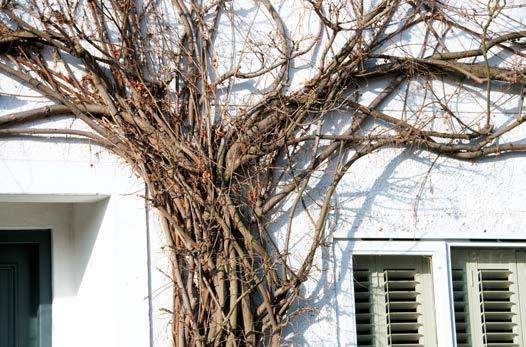
Before Winter pruning is done in January to February, before the flower buds emerge. The idea is to prune hard back to encourage flowering spurs, remove dead wood and weak branches. You’ll need sharp, clean loppers or secateurs and a steady ladder.
Step 2 Tidy up flower spurs, removing dead twigs and foliage stems to create a clear, open habit for flower production.
Step 4 Shorten the remaining flower spurs back to two or three buds by making a sharp upward cut above, but not close enough to damage the selected remaining buds. This tidies the vine and allows sunlight to reach the flower buds. Step 1 Tidy up and maintain the wisteria’s framework. Remove congested stems, dead wood, old foliage and long whips to focus the plant’s energy on producing flowering spurs, not vegetative growth. Leave any stems required to extend the framework.
Step 3 Remove congested stems, leaving upright flowering spurs at regular intervals of around 30-40cm.
Step 5 Loosely tie in any whippy shoots or stems with wire or twine, to extend your framework upwards or outwards. Then remove all debris (Chris uses a leaf blower). The end result should be a framework of well-spaced branches with stumpy spurs.
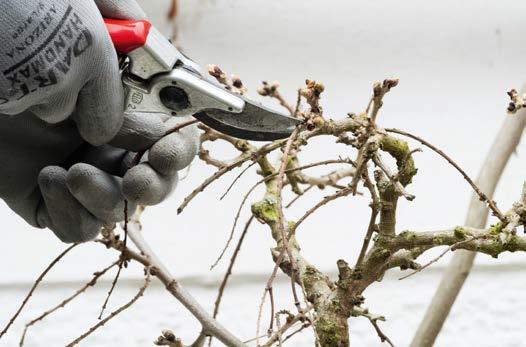
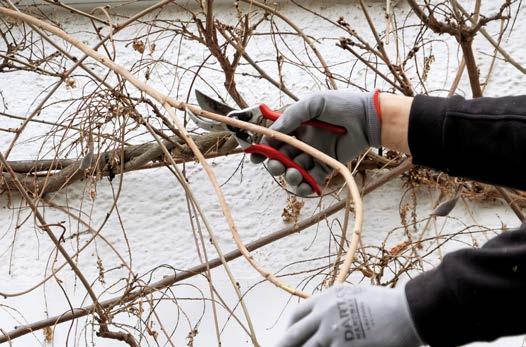



Gardens to Visit
Be inspired by a magnificent, mature wisteria in full bloom
Waterperry Gardens Oxfordshire
Expect exemplary pruning and training at Waterperry, where the pergola in the Formal Garden drips with long racemes of Wisteria floribunda. waterperrygardens.co.uk
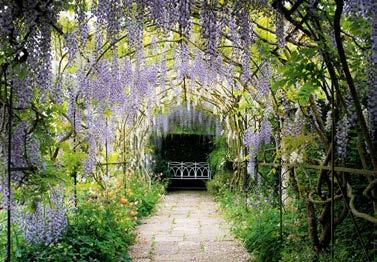
Sissinghurst Kent
A visit to the gardens of Sissinghurst will always be enjoyable, but the white wisteria hanging over the walls of the Moat Walk is extra special in spring. nationaltrust.org.uk

Wrest Park Bedfordshire Superbly trained to cover the length of an entire wall in the Italian Garden, this venerable wisteria is just one reason to visit elegant Wrest Park. english-heritage.org.uk


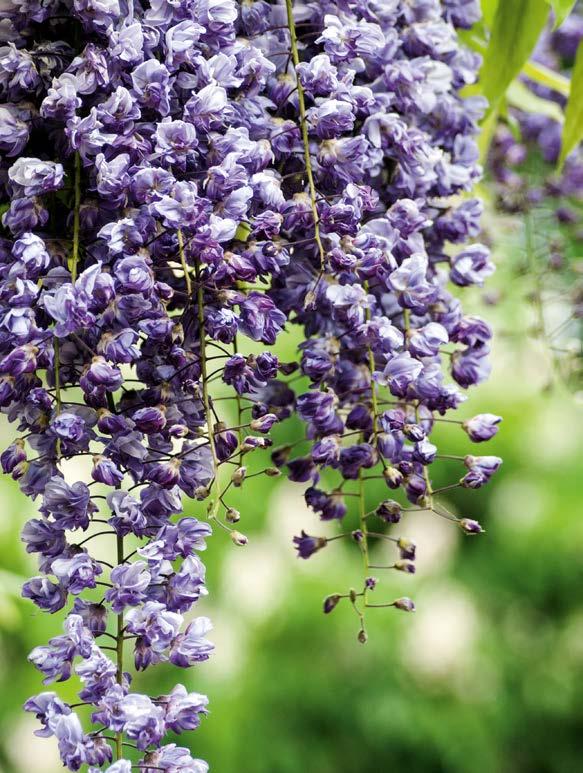
Top Double-flowered Wisteria ‘Yae-kokuryu’ or ‘Black Dragon’. Above ‘Shiro-noda’ bears showers of long white flowers and, because it is less vigorous, is a good choice for fences or trellis in smaller gardens.
Wisteria also needs to be given a robust climbing frame: a sturdy wooden or metal arbour, pergola or stout trellis on which to train the vine. Horizontal wires fastened to strong, metal, wall-fixed vine eyes will provide optimum support for wall-trained wisteria. Loosely tie in lead shoots, leaving ample room for growth of girth. Fertilise the soil annually in March with a potash- and magnesium-rich rose feed to help promote abundant blooms, but “bi-annual pruning is key to keeping your wisteria under control and maximising its flowering potential,” Chris confirms. n
Contact Chris O’Keefe at The London Wisteria Company. Tel: 07967 357 907; londonwisteria.co.uk

THE TOOLS YOU NEED
WINNER OF THE GREEN THUMB AWARD



RootSlayer is the world’s first manufacturer of gardening tools with its range of multifunctional tools. RootSlayer will allow you to carry out a multitude of gardening tasks without having to use several tools at the same time. We have rethought every aspect of every tool we have made so that you can have a better, more comfortable and above all an efficient gardening experience. Work professionally right from the comfort of your own home. Discover our range of rootslayer’s products on our website www.rootslayer.uk with free delivery.
@rootslayerfr



Gold Standard
With its boughs laden with brilliant yellow blooms, forsythia earns its place as a spring garden stalwart
Subtle is not an epithet anyone ever applied to forsythia, the well-known shrub that turns the colour of a Colman’s Mustard tin each April. For many gardeners, it is a step too far. But no one can deny its cheerfulness, and if you enjoy cutting garden fl owers, its branches bring a ray of spring sunshine into your home, often at Easter.
Forsythia belongs to the olive family, Oleaceae, its species mainly found in east Asia. Botanist Carl Peter Thunberg spotted Forsythia suspensa in a Japanese garden in the late 18th century. By 1833 F. suspensa had made its way to Holland, and by the middle of the century Veitch Nurseries were selling it in England. At around the same time, Scottish plant hunter Robert Fortune discovered F. viridissima in China. He sent it back to the Horticultural Society (the society only became ‘Royal’ in 1861), in whose garden it fl owered in 1847. Nurserymen crossed the two species and it was this breeding that gave us Forsythia x intermedia and its hybrids, which make up most of the forsythia on off er today.
The shrub was named after William Forsyth, an Aberdeenshire man who trained at the Chelsea Physic Garden and was superintendent of the royal gardens at Kensington and St James’s Palace from 1784 until his death in 1804. He was one of the Royal Horticultural Society’s founder members, and great-grandfather of landscape gardener Joseph Forsyth Johnson who was, in turn, greatgrandfather to the entertainer Bruce Forsyth.
HOW TO GROW
Forsythia is an easy shrub to grow in sun or light shade, doing best on rich soil since it’s a hungry plant. After the fl owers have faded, its mid-green leaves look rather plain, so plan to grow something else nearby to supply interest from early summer onwards.
Forsythia always look best left to grow naturally, without pruning. In Trees and Shrubs Hardy in the British Isles, the oracle W.J. Bean suggests siting them: “where they can grow freely yet are not so remote from the comings and goings of daily life that the birds can destroy their fl ower-buds undisturbed.” Other than avian interference, expect few problems.
The shrub featured in the 2011 fi lm Contagion by Steven Soderbergh, which was prescient of the Covid-19 pandemic. Jude Law played a conspiracy theorist who claimed a forsythia-based remedy could cure the fi lm’s deadly virus. Does Steven Soderbergh have a penchant for yellow spring shrubs, perhaps? ■
Forsythia: Three fi ne garden-worthy cultivars – and a non-yellow alternative
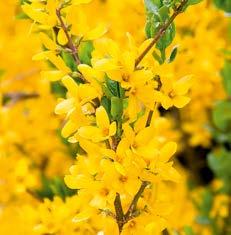



‘Lynwood Variety’, widely available, reliable classic. ‘Minigold’, perfect for pots reaching just 1m tall. ‘Marée d’Or’ has a low habit useful for groundcover.
Abeliophyllum distichum, a relative with white fl owers.
Garden buildings offer valuable extra living space and you can select a building to fit specific needs. This conservatory is by Vale Garden Houses.

The Great Indoors
Chosen wisely, a garden room, conservatory, greenhouse or even a humble shed can dramatically increase usable space for living and working at home, often bringing a cheerful outdoor mood to a place of comfortable shelter






